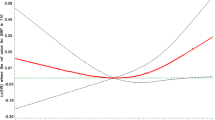Abstract
The added value of blood pressure (BP) trajectories for predicting cardiovascular disease (CVD) is currently unknown. We investigated the association of systolic BP (SBP) trajectories with CVD and all-cause mortality and compared these associations with those of average SBP, taking antihypertensive medication into account. Data from 762 participants of the Rancho Bernardo Study were used. SBP from five examinations (maximum) from 1984 to 2002 was used; mortality data were obtained from 2002 to 2013. SBP trajectories were derived using group-based trajectory modelling. Cox proportional hazards analysis was used to investigate associations of trajectories and average SBP with CVD and all-cause mortality, adjusted for age, sex, cholesterol, smoking, diabetes and antihypertensive medication. Mean baseline age was 65.7 years, and 67% were women. Four trajectories were identified, in which mean SBP increased by 5–12 mm Hg during 10 years. The highest trajectories were associated with two to three times greater CVD mortality and 1.5 times greater all-cause mortality risk, compared with the lowest trajectory. Each 20 mmHg increment in average SBP was associated with 1.4 times greater CVD mortality risk and 1.2 times all-cause mortality risk. Associations were not modified by antihypertensive medication (P-interaction>0.10). SBP trajectories were not superior to average SBP in predicting CVD and all-cause mortality. In the general middle-aged and older population of the Rancho Bernardo study, SBP trajectories provided no added value to average SBP in predicting CVD and all-cause mortality. Long-term average SBP levels and trajectories were significant predictors of CVD and all-cause mortality, irrespective of prescribed antihypertensive medication (which in the 1980s–1990s mainly were diuretics and β-blockers).
This is a preview of subscription content, access via your institution
Access options
Subscribe to this journal
Receive 12 digital issues and online access to articles
$119.00 per year
only $9.92 per issue
Buy this article
- Purchase on Springer Link
- Instant access to full article PDF
Prices may be subject to local taxes which are calculated during checkout

Similar content being viewed by others
References
Lewington S, Clarke R, Qizilbash N, Peto R, Collins R, Prospective Studies Collaboration. Age-specific relevance of usual blood pressure to vascular mortality: a meta-analysis of individual data for one million adults in 61 prospective studies. Lancet 2002; 360 (9349): 1903–1913.
Tielemans SMAJ, Geleijnse JM, Menotti A, Boshuizen HC, Soedamah-Muthu SS, Jacobs DR Jr et al. Ten-year blood pressure trajectories, cardiovascular mortality, and life years lost in 2 extinction cohorts: the Minnesota Business and Professional Men Study and the Zutphen Study. J Am Heart Assoc 2015; 4 (3): e001378.
Theodore RF, Broadbent J, Nagin D, Ambler A, Hogan S, Ramrakha S et al. Childhood to early-midlife systolic blood pressure trajectories: early-life predictors, effect modifiers, and adult cardiovascular outcomes. Hypertension 2015; 66 (6): 1108–1115.
Petruski-Ivleva N, Viera AJ, Shimbo D, Muntner P, Avery CL, Schneider AL et al. Longitudinal patterns of change in systolic blood pressure and incidence of cardiovascular disease: The Atherosclerosis Risk in Communities Study. Hypertension 2016; 67 (6): 1150–1156.
Portegies ML, Mirza SS, Verlinden VJ, Hofman A, Koudstaal PJ, Swanson SA et al. Mid- to late-life trajectories of blood pressure and the risk of stroke: The Rotterdam Study. Hypertension 2016; 67 (6): 1126–1132.
Allen NB, Siddique J, Wilkins JT, Shay C, Lewis CE, Goff DC et al. Blood pressure trajectories in early adulthood and subclinical atherosclerosis in middle age. JAMA 2014; 311 (5): 490–497.
Franklin SS, Larson MG, Khan SA, Wong ND, Leip EP, Kannel WB et al. Does the relation of blood pressure to coronary heart disease risk change with aging? The Framingham Heart Study. Circulation 2001; 103 (9): 1245–1249.
Barrett-Connor E . The Rancho Bernardo Study: 40 years studying why women have less heart disease than men and how diabetes modifies women's usual cardiac protection. Glob Heart 2013; 8 (2): 95–104.
The Hypertension Detection and Follow-Up Program Cooperative Group. The Hypertension Detection and Follow-Up Program. Prev Med 1976; 5 (2): 207–215.
Jones BL, Nagin DS, Roeder K . A SAS procedure based on mixture models for estimating developmental trajectories. Sociol Methods Res 2001; 29 (3): 374–393.
Akaike H . A new look at the statistical model identification. IEEE Trans Automat Control 1974; 19: 716–723.
Wu Z, Jin C, Vaidya A, Jin W, Huang Z, Wu S et al. Longitudinal patterns of blood pressure, incident cardiovascular events, and all-cause mortality in normotensive diabetic people. Hypertension 2016; 68 (1): 71–77.
James PA, Oparil S, Carter BL, Cushman WC, Dennison-Himmelfarb C, Handler J et al. 2014 evidence-based guideline for the management of high blood pressure in adults: report from the panel members appointed to the Eighth Joint National Committee (JNC 8). JAMA 2014; 311 (5): 507–520.
Acknowledgements
This work was supported by the Royal Netherlands Academy of Arts and Sciences. The Rancho Bernardo Study was funded by research grants AG028507 and AG07181 from the National Institute on Aging and grant DK31801 from the National Institute of Diabetes and Digestive and Kidney Diseases.
Author information
Authors and Affiliations
Corresponding author
Ethics declarations
Competing interests
The authors declare no conflict of interest.
Additional information
Supplementary Information accompanies this paper on the Journal of Human Hypertension website
Supplementary information
Rights and permissions
About this article
Cite this article
Tielemans, S., Geleijnse, J., Laughlin, G. et al. Blood pressure trajectories in relation to cardiovascular mortality: The Rancho Bernardo Study. J Hum Hypertens 31, 515–519 (2017). https://doi.org/10.1038/jhh.2017.20
Received:
Revised:
Accepted:
Published:
Issue Date:
DOI: https://doi.org/10.1038/jhh.2017.20
This article is cited by
-
Modelling of longitudinal data to predict cardiovascular disease risk: a methodological review
BMC Medical Research Methodology (2021)
-
Association between microinfarcts and blood pressure trajectories
Journal of Human Hypertension (2018)



